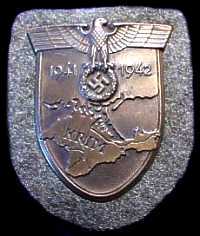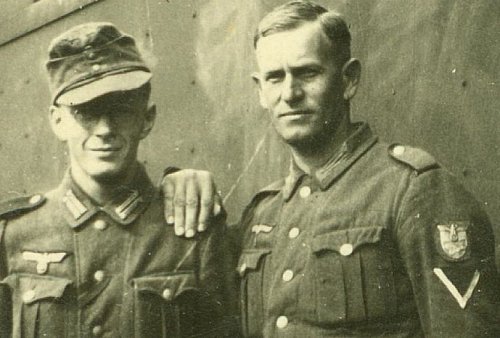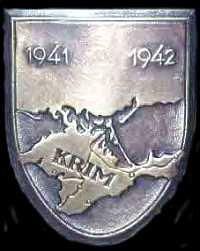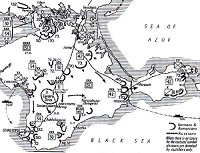
By Sebastián Bianchi
The Krim Shield was instituted on July 7th, 1942, and was to commemorate the German advance into
the Crimea led by General
von Manstein.
Shield Properties
| The award took the form of a shield with a rounded bottom. An eagle is
positioned on the top, with its outstretched wings spreading across, not
only the entire width of the shield, but also breaking the edges to both
sides. This eagle is the standard Wehrmacht Eagle, and as such is holding
in its talons a wreath with a centered swastika. On either side of the
wreath are the years 1941-1942, during which time the conquest took place.
The body of the shield is decorated with a map of the Crimea. The details on the map include the rivers, and six main cities in the area (denoted by a circle). The word “KRIM” is also imprinted on the map. Around the whole shield, up to the eagles’ wings, is an edge with a small intrusion, with the left side of the map protruding into this edge. |
 |
The shield was affixed to the uniform via a cloth back that was held by a back plate. There were several variations on the back plate attachment method, with the most popular being four prongs on the back, two on the top and two directly below them. The cloth backing, as with all shields, matched the color of the recipients’ uniform.
Krim Shield in Gold
General von Manstein had a special issue of the Krim created. This shield, which was produced in pure gold, was presented by him to Marshal Antonescu as recognition for the role of the Rumanian forces in the conquest of the Crimea. Von Manstein had one of these shields presented to him by members of his staff sometime later, and used the shield design on his aircraft as a victory sign.
The Battle
The battle is covered in detail in its own page which can reached by clicking on the map below;
Award Criteria and Statistics
The award was presented to all members of the 11th German Army and the 3rd Rumanian Army that participate in the campaign. The specific criterion follows,
- To have served in the region for 3 months
- To have taken part in at least one major combat operation.
- To have been wounded while serving in the region.
These specifications were set up in part to prevent General Staff officers to receive the award from “official visits” to the area.
Each recipient was entitled to five copies of the award, and more could be purchased if necessary through LDO outlets by producing the award document that was presented with the shield. Posthumous awards were made to the family of the fallen soldier accompanied by a possession certificate.
As with all campaign shields the award was worn on the upper left sleeve of the uniform, and was authorized for wear on virtually every type of uniform, including the brown party uniform. It is estimated that 150,000 to 250,000 were produced and 100,000 presented.

Krim Shield 1957

In 1957, the Krim shield was re-issued without the swastika as pictured.
![]()
© Copyright Wehrmacht-Awards.com LLC |
